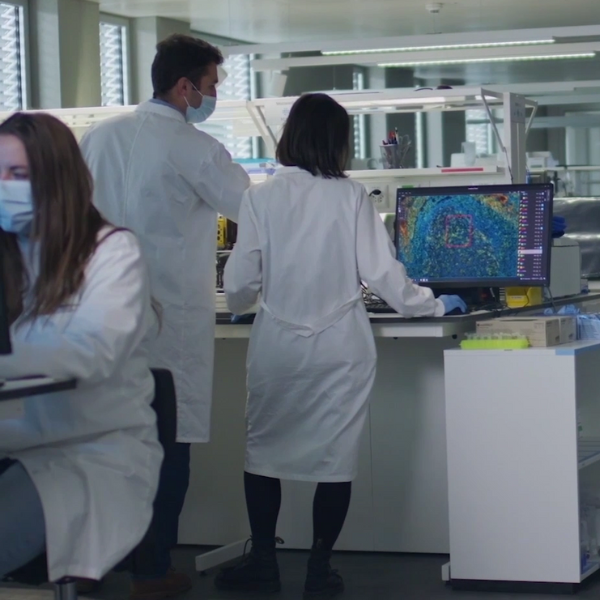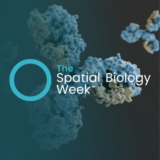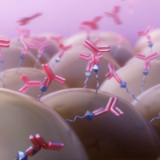Webinar
The Spatial Biology Week™ 2022: accelerating discoveries through a spatial lens
Posted on:

The Spatial Biology Week™ brought experts from industry and academia together for the second time to discuss innovations and insights in the spatial biology field. The 1-week online meeting explored how new, cutting-edge technology solutions in spatial biology can accelerate research and help scientists and clinicians gain a profound knowledge of the underlying pathophysiological states of diseases.
Other fields of study focus solely on the statistical presence or absence of cells and molecules, and non-spatial platforms hinder more significant insights into the tissue context. Spatial biology adds a new dimension, providing additional understanding into molecule co-expression, cell-to-cell interaction, and cell-to-microenvironment interaction.
Through the previous two blog posts presenting the takeaways of The Spatial Biology Week™, it has become clear that the field’s leaders agree that spatial biology platforms fill the gap of limitations of other current technologies, and spatial biology is at the forefront of scientific discovery.
Spatial biology unlocks new frontiers
During the virtual meeting, presenters highlighted that spatial biology has the potential to drive hypothesis generation instead of just confirming them. By harnessing spatial biology’s full potential, researchers can advance biomarker discovery and, ultimately, develop the next generation of personalized medicine.
Biomarker validation is essential for quality data generation; however, it can be time-consuming. With new technology platforms, some show capabilities to optimize antibodies quickly, without compromising data quality and reproducibility. By leveraging quantifiable immunofluorescence to gather more insights from every sample, there may be a time in the near future when new biomarkers are being discovered while running validations for other targets.
Dr. Joe Yeong, Group Leader at the Technology and Research (A*STAR)’s Institute of Molecular and Cell Biology (IMCB), talking about biomarkers, said, “it could be an AI combination, but I foresee something discovered from spatial technology and translated to a clinical setting. I think this is for sure coming, and it should be soon.” During her presentation, Dr. Ghislaine Lioux, Senior Field Applications Scientist at Indica Labs, also reinforced the unfolding promise of translating spatial insights to achieve clinical impact by showing how the combination of powerful machines and analysis tools “can be a first step towards therapy design.”
Similarly, Dr. Denis Schapiro, Group Leader at Heidelberg University Hospital, expressed that he envisions biomarkers obtained through spatial biology will be integrated into clinical cancer diagnostics. “I think that’s the vision of everyone here who is part of this field and community, that we want to bring this into diagnostic. I think we are still a few years away, but we are on the right way.”
With spatial biology platforms being adopted in more labs around the world, it is inspiring to see how these game-changing technologies are moving closer to the clinic, where they will be able to benefit patients’ lives directly.
Breaking down the barriers: enabling spatial biology in every laboratory
New technologies in spatial biology can provide a bridge to the next generation of personalized therapies. For this reason, selecting a spatial biology platform to perform automated hyperplex analysis is a critical decision for laboratories. Dr. Pedro Almeida, Application Development Scientist at Lunaphore, believes that “high complexity and technical barriers prevent the wide adoption of spatial proteomics.” He explained how COMET™ enables hyperplex panels to be developed in days – not months – with high tissue preservation and signal stability, supporting much-needed research flexibility. His presentation also featured how this novel and intuitive technology address the above- mentioned issues of adoptation with:
- end-to-end automation;
- high throughput;
- openness with the capability to use any off-the-shelf antibodies the way the lab already uses them;
- production of more data faster.
Hence, the platforms advancing spatial biology need to provide the entire package and have a robust support offering for widespread adoption. As Dr. Michael Surace, Director of AstraZeneca, said, “the maturity of the platform and the ability of the support group to address tech challenges as they arise in the lab and on the ground is really important.”
Markus D. Herrmann, MD, Ph.D. Assistant Professor of Pathology, Harvard Medical School & Director of Computational Pathology Massachusetts General Hospital, in his talk on the last day of The Spatial Biology Week™, discussed how the complete package of scientific excellence, ease of use, and support could help drive adoption of spatial biology and automated image analysis: “There may still be a hurdle and most of the interested biology labs may not necessarily have the infrastructure available or the tools or expertise to develop the image analysis algorithms themselves. Thus, solutions, as we’ve seen [in these presentations], are very helpful for a lot of labs out there.”
Versatility accelerates discovery: bringing spatial profiling to a broad and immediate set of applications
If we learned one thing from The Spatial Biology Week™ 2022, it is that from discovery to translational research, from an academic lab to a core facility or in a pharmaceutical or CRO setting, the versatility of spatial biology is unmatched. Platforms mentioned during The Spatial Biology Week™ are cutting-edge spatial biology innovations. Thanks to these open, flexible, and automated solutions, a wide variety of biological questions can be answered quickly. These unique capabilities enable researchers to design various panels across diverse tissue types simultaneously in an efficient manner. While current applications for this technology are primarily used in the immuno-oncology (IO) space, there is also great potential in immunology, neuroscience, and cardiovascular disease, among other research areas.
Regarding the other possible use cases for spatial biology, Dr. Matthew Pugh, Clinical Research Training Fellow at the University of Birmingham, stated, “I think any area of research in which tissue is used, human or otherwise, is a potential application. The most obvious outside of IO is immunology, inflammatory-type diseases, infectious disease, and essentially the technology is applicable to anything with a cellular or histological basis for the disease. Your imagination is the limit.”
Lunaphore would like to thank all speakers and attendees who participated in The Spatial Biology Week™ 2022. We look forward to continued collaboration and research endeavors as we harness these learnings to use spatial solutions to their full potential and advance them into the clinical setting where they can provide valuable benefits for patients in the future.

